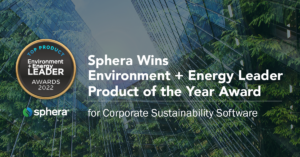The need for transparent, auditable and standardized ESG data is the catalyst for the changes we’re currently seeing in the corporate sustainability reporting landscape. There are growing expectations from regulators, consumers and investors alike, not only for businesses to report climate risk data but also to do so in a way that’s comparable. For example, new European disclosure rules under the Corporate Sustainability Reporting Directive (CSRD) and the U.S. Securities and Exchange Commission’s (SEC) climate-related disclosure rules mandate that companies report Scope 1, 2 and 3 emissions.
Complying with disparate regulations and reporting frameworks across the globe adds a layer of complexity for organizations. There is a lack of standardized metrics for ESG reporting and a need for greater direction on how to approach it. Standardization will allow stakeholders to better assess investments and more accurately align them to their values and investment goals.
While reporting Scope 1 and 2 emissions will be important for complying with current and upcoming regulations and reducing carbon emissions, Scope 3 emissions often represent the largest share of businesses’ greenhouse gas (GHG) emissions. Scope 3 emissions include indirect emissions that come from a company’s value chain, both upstream and downstream.
Tackling Scope 3 emissions can seem daunting, but no organization needs to face these challenges alone. Working together across industries and countries will be essential to reducing Scope 3 emissions and meeting climate targets. With the United Nations’ Intergovernmental Panel on Climate Change (IPCC) announcing that we’ll need to reach net zero emissions by 2050 and cap warming at 1.5 degrees Celsius (2.7 degrees Fahrenheit) to prevent the worst effects of climate change, the time to take action to reduce GHG emissions is now.
Building capacity for Scope 3 reporting represents a significant compliance challenge for organizations, especially for those with complex value chains that span multiple industries and geographies. Facing these challenges requires an operationalized approach to ESG that accounts for the complexity of Scope 3 emissions. This includes understanding the climate impacts of the design and manufacturing of a company’s products, as well as employee travel and the emissions that come from suppliers and the shipment of goods to customers.
That’s why we’re focused on helping businesses quantify their emissions baseline for the entire value chain through our Life Cycle Assessment (LCA) databases and LCA automation software solution, which helps businesses compare their products’ carbon footprints to others in their industry and calculate life cycle assessments at scale. Speaking of software, SpheraCloud Corporate Sustainability received a Top Product of the Year Award from Environment + Energy Leader this month. Our Corporate Sustainability software provides a real-time view into a company’s sustainability performance, including Scope 1, 2 and 3 emissions data and reporting for current and emerging regulatory standards. Innovative software solutions like SpheraCloud Corporate Sustainability help businesses manage and report the ESG data that will be needed to meet net-zero emissions targets.
A sustainable supply chain will be key to reducing Scope 3 emissions and transitioning to a net-zero economy. Setting goals through the Science-Based Targets initiative (SBTi) will create effective decarbonization strategies to achieve emissions reduction within the supply chain. Our consultants help businesses screen Scope 3 emissions and identify hotspots for improvement, resulting in more sustainable supply chains. This leads to the improved ESG performance that investors, regulators and the public want to see.
No matter what new regulations may come, having ESG at the center of business operations allows organizations to truly understand performance and drive Scope 3 emissions reduction. When businesses commit to reporting ESG data as a regular exercise, as they do for financial reporting, it results in an operationalized approach that provides the most holistic view of a company’s ESG performance.
I encourage companies to treat ESG as a journey that will help create a safer, more sustainable and productive world for us all. While the path to reduced Scope 3 emissions and net zero is a long one, with the right data, software and expertise, we will succeed.
–Paul






